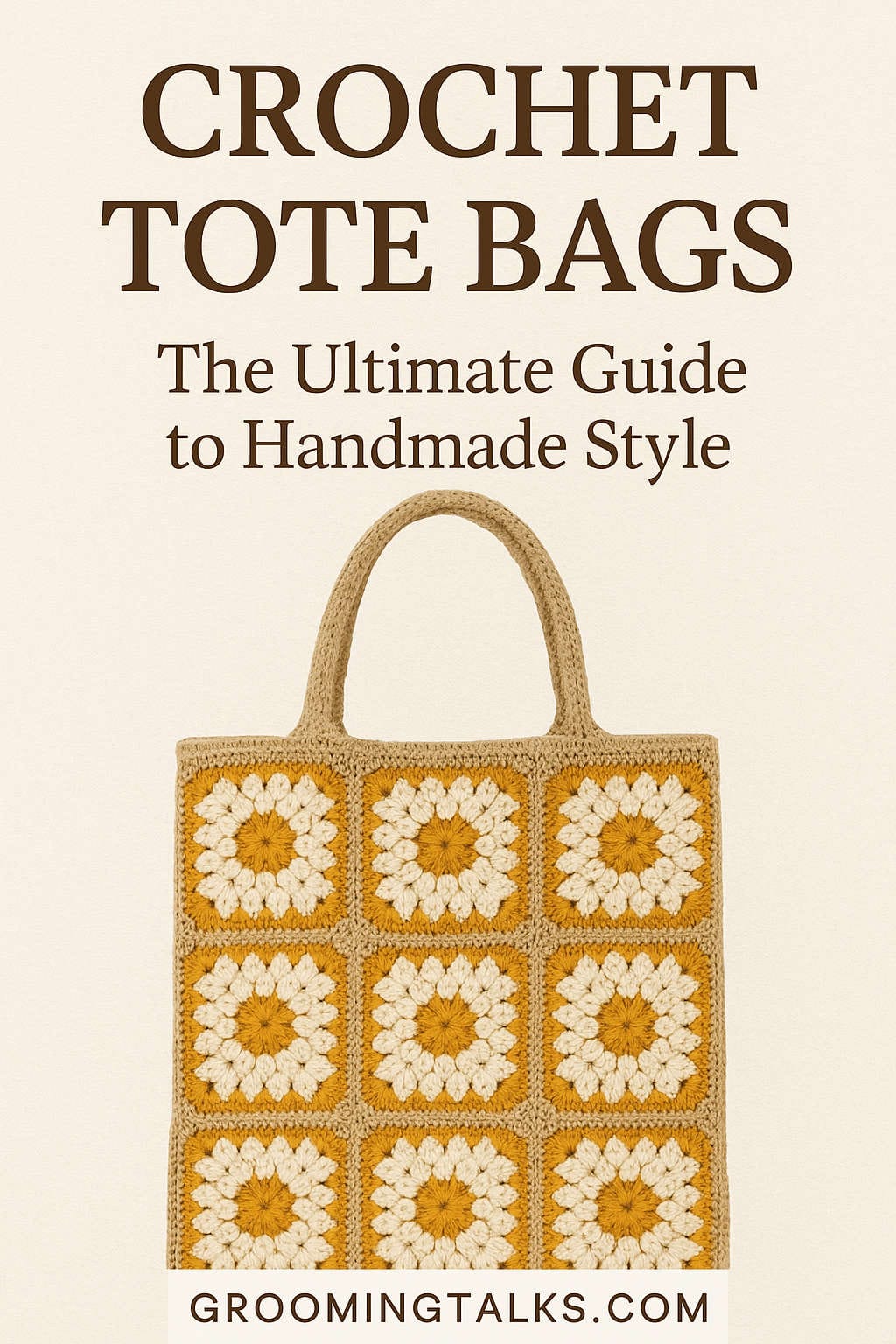In today’s fast-paced, machine-made world, the charm of handcrafted items is more appreciated than ever. Among these treasures, crochet has carved out a special place. This traditional craft isn’t just about making pretty things with yarn—it’s a creative journey rooted in history, storytelling, and individuality. One shining example of crochet’s beauty and functionality is the artisanal crochet tote bag.
Crochet tote bags aren’t just accessories; they’re wearable art. Whether used for grocery runs, beach days, or brunch outings, these bags fuse purpose with personality. In this comprehensive guide, we’ll take you through the rich world of crochet craftsmanship, focusing on the design and making of artisanal totes. From history to materials, techniques to trends, you’ll learn everything you need to know about the timeless appeal of these handmade wonders.
A Stitch Through Time: The History of Crochet
The exact origins of crochet are debated, but most historians agree it has European roots, possibly evolving from techniques like tambour embroidery and needle lace. The craft rose to prominence in the 1800s, particularly in Ireland during the Great Famine, where women created intricate lace pieces to sell and support their families.
Crochet flourished throughout the 19th and 20th centuries, showing up in everything from home decor to haute couture. It experienced major resurgences during the 1970s hippie movement and again in the 2020s, as part of the slow fashion and DIY renaissance.
Crochet isn’t just a trend; it’s a living, evolving art form. And when it comes to tote bags, that artistry shines in every loop, knot, and stitch.
Why Crochet Tote Bags Stand Out
Crochet totes offer more than just a way to carry your belongings. Here are a few reasons they have become beloved staples:
1. Unique Texture & Design
Each bag has its own fingerprint. The texture created by different stitches adds depth, dimension, and personality to even the simplest design.
2. Sustainability
Handmade crochet totes are often created using natural or recycled fibers. Compared to factory-made accessories, these are significantly more eco-friendly.
3. Customizability
From stitch patterns to yarn colors and bag shapes, artisans can tailor each design to the maker’s or buyer’s tastes.
4. Durability
With the right materials and stitches, crochet totes can be surprisingly strong, making them ideal for everyday use.
Essential Elements of Artisanal Crochet Tote Design
Creating a crochet tote involves more than just following a pattern. Let’s explore the core elements that make a tote bag both functional and beautiful.
1. Choosing the Right Pattern
The structure of a tote begins with its pattern. Whether you’re designing from scratch or using a template, you must consider:
- Bag Shape: Rectangular, square, circular, or even hexagonal.
- Bag Size: Small and chic, or roomy and practical.
- Stitch Density: Tighter stitches for durability; looser ones for a lighter look.
Patterns range from minimalist meshes to intricate motifs like granny squares or floral overlays.
2. Selecting the Perfect Yarn
Yarn choice affects texture, weight, appearance, and usability. Consider the following fibers:
- Cotton: Ideal for structure and washability.
- Linen: Offers a sleek finish and great strength.
- Hemp or Jute: Eco-friendly and very sturdy.
- Recycled Yarns: Made from leftover textiles or plastics—great for sustainability.
3. Mastering the Stitches
Different stitches offer different results. Popular choices for tote bags include:
- Single Crochet (SC): Tight, firm, and great for solid structures.
- Half Double Crochet (HDC) and Double Crochet (DC): Slightly more open, adds height and speed to your work.
- Popcorn and Bobble Stitches: Add decorative texture.
- Tapestry Crochet: Used for intricate colorwork and patterns.
- Mesh and Lace: Good for lightweight, summery totes.
4. Strap Construction
The straps must be strong and comfortable. Options include:
- Crocheted Handles: Reinforced for durability.
- Leather or Faux Leather: Adds a stylish, professional finish.
- Wooden or Bamboo Rings: Great for a natural, vintage vibe.
5. Finishing Touches
What sets a basic tote apart from an artisanal one?
- Fabric Lining: Adds strength and prevents stretching.
- Zippers or Magnetic Closures: Secure your belongings.
- Pockets: Useful and practical.
- Tassels, Pom-Poms, Embroidery: Personalize the look.
Handcrafted vs. Machine-Made: What Makes Artisanal Better?
In a sea of mass-produced fashion, handmade crochet totes stand out. Here’s why:
Artisanal Totes:
- Made one at a time, often by independent makers.
- Embrace imperfections that give each bag a unique character.
- Crafted with quality materials and attention to detail.
- Often support local economies or women-led businesses.
Machine-Made Totes:
- Uniform and often synthetic.
- Designed for high-volume sales, not longevity.
- Lack the story, emotion, and connection that comes with handmade goods.
If you’re looking for more than just a bag—something that tells a story and supports a craftsperson—go artisanal.
Spotlight on a Technique: Tapestry Crochet
Tapestry crochet is a technique where multiple yarns are carried and worked simultaneously, creating intricate patterns and even images within the fabric.
- Color Control: Yarns not in use are carried along the top and crocheted over, allowing for clean color transitions.
- Design Potential: From geometric designs to animals and abstract art.
- Durability: The dense stitching adds structure, perfect for tote bags.
This technique has cultural roots in South America and is often used in traditional Wayuu bags from Colombia.
Cultural Significance: More Than Just Fashion
Around the world, crochet is part of cultural identity and heritage.
- Latin America: Brightly colored tapestry crochet patterns are a staple in many indigenous communities.
- Africa: Artists combine crochet with recycled materials to create bold statement pieces.
- Southeast Asia: Artisans use native fibers like abaca and raffia to create textured, sustainable totes.
Buying or learning these styles supports cultural preservation and fosters appreciation for global craftsmanship.
The Eco-Friendly Advantage of Crochet Totes
Sustainability is more than a trend—it’s a necessity. Crochet totes naturally align with eco-friendly values:
- Low Waste: Makers can create bags with minimal leftover material.
- Natural Fibers: Biodegradable and renewable.
- Recycled Materials: Breathing new life into old resources.
- Slow Fashion: Built to last, not to be discarded next season.
Each handmade bag replaces countless plastic or synthetic alternatives, making a real difference over time.
DIY: Make Your Own Crochet Tote Bag
Want to give it a try? Creating your own crochet tote is incredibly fulfilling. Here’s a basic roadmap:
1. Learn the Basics
- Master foundational stitches: SC, HDC, DC.
- Practice on small projects like coasters or dishcloths.
2. Choose a Beginner Pattern
- Look for free or paid patterns with step-by-step instructions.
- YouTube and crochet blogs are fantastic learning tools.
3. Gather Materials
- Yarn (preferably cotton for structure)
- Crochet hook (size suggested by yarn label)
- Stitch markers, scissors, tapestry needle
4. Take Your Time
Don’t rush the process. Enjoy each stitch and celebrate your progress.
5. Add Your Signature
Customize your tote with embellishments, personalized colors, or a tag with your initials.
Trends in Crochet Tote Design (2025 and Beyond)
Designers and makers are pushing the boundaries of what a crochet tote can be. Here are some top trends to watch:
1. Patchwork and Modular Totes
Granny squares and modular motifs offer creative freedom and easy assembly.
2. Eco Innovations
Yarns made from seaweed, coffee grounds, and recycled denim are making their way into crochet.
3. High Fashion Collabs
Luxury designers are partnering with artisans to bring crochet into high fashion.
4. Tech-Enhanced Making
Digital patterns, augmented reality tutorials, and AI-generated stitch guides are redefining how we learn and create.
5. Functional Hybrids
Backpack totes, crossbody crochet bags, and convertible styles are gaining popularity.
Supporting the Makers: Ethical Shopping Tips
If you’re not into crafting, you can still support the movement by buying from ethical sources:
- Check the Origin: Look for artisan stories and transparent sourcing.
- Shop Small: Buy from Etsy shops, Instagram creators, and local craft fairs.
- Look for Certifications: Fair trade, handmade, or women-owned tags.
- Ask Questions: Engage with makers about their process and materials.
When you support handmade, you invest in skill, tradition, and community.
Final Thoughts: Carrying More Than Just Stuff
A crochet tote bag isn’t just something to sling over your shoulder. It’s a statement of who you are, what you value, and what kind of world you want to live in. It blends creativity, sustainability, and tradition into something you can take anywhere.
Whether you make one yourself or buy from a talented artisan, each tote carries a story—a story woven with time, talent, and care. In every loop and stitch, there is love, culture, and purpose.
So next time you reach for a bag, make it one that means something.
Want to dive deeper into crochet? Stay tuned for upcoming tutorials, pattern recommendations, and interviews with artisans around the globe. Your journey into the world of crochet totes is just beginning.






